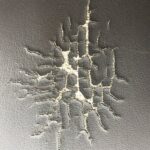Experiencing distorted or muffled sound from your car speakers? It might be a sign of a blown speaker, a common issue for car audio enthusiasts. Before you rush to replace your speakers, especially in a BMW, it’s crucial to understand the potential root causes. This guide will walk you through diagnosing and addressing a blown car speaker, with a focus on common issues in BMW sound systems.
Identifying Your BMW Sound System
BMW vehicles often come with different audio system options, and knowing which one you have is the first step in troubleshooting. There are typically three main types, excluding variations based on the head unit:
- Stereo (Base System): This is the standard system with no external amplifier.
- HiFi (Option 676): An upgraded system that includes a small amplifier. In many BMW models, this amplifier is located behind the passenger side wheel well in the US.
- Top HiFi/Logic 7 (Option 677 or 688): The premium sound option, featuring a more powerful amplifier in the same location as the HiFi amp. Option codes can vary by year.
To determine your BMW’s sound system, use a VIN decoder website like Mdecoder.com. Enter your VIN, and look for option codes in the 6xx range. This will confirm whether you have the base Stereo, HiFi, or Top HiFi system.
Is it Really a Blown Speaker? Consider the Amplifier First
While a blown speaker is a possibility, in BMWs with HiFi or Top HiFi systems (options 676, 677, or 688), a more frequent culprit is water damage to the amplifier. The amplifier’s location behind the wheel well makes it susceptible to moisture intrusion over time. Water damage can lead to audio distortion or speaker malfunction, mimicking the symptoms of a blown speaker.
Therefore, before assuming you need to repair or replace your car speaker, especially in these BMW systems, investigate the amplifier first.
Checking Your Amplifier for Water Damage
Accessing the amplifier location typically involves removing interior trim panels in the trunk or cargo area, near the passenger side wheel well. Carefully inspect the amplifier and the surrounding area for any signs of water ingress, corrosion, or water stains. If you find evidence of water damage, addressing the amplifier issue might resolve your audio problems without needing to repair the speakers themselves. HiFi amps can often be found affordably on online marketplaces, potentially saving you significant repair costs compared to dealer prices. Logic 7 amps are pricier but still might be a more effective fix than speaker replacement if water damage is the issue.
Speaker Repair or Replacement
If, after checking the amplifier, you still suspect a blown speaker, or if you have a base Stereo system (without an external amp), then focusing on the speaker itself becomes relevant. Keep in mind that BMW door speakers are generally designed to handle mid and high frequencies, with bass frequencies typically directed to under-seat subwoofers. Replacing door speakers might be necessary if they are genuinely blown, but ensure you’ve ruled out amplifier problems first, especially in HiFi and Top HiFi systems.
For DIY speaker repair or replacement, online resources and forums dedicated to BMWs, like the E90post forums mentioned in the original text, can provide valuable door panel removal procedures and guidance. YouTube tutorials for your specific BMW model (e.g., E90) are also excellent resources for visual learners.
Conclusion
Diagnosing a “blown” car speaker in a BMW, particularly those with upgraded sound systems, requires a bit of investigation. While speaker damage is possible, water-damaged amplifiers are a more common issue in HiFi and Top HiFi setups. By systematically checking your sound system type and inspecting the amplifier for water damage, you can accurately pinpoint the problem and pursue the most effective repair solution, whether it’s amplifier replacement or speaker repair. Remember to consult online DIY resources for specific procedures related to your BMW model.

